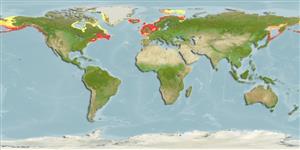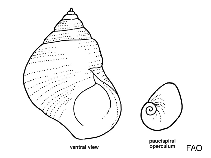Lacuna vincta (Montagu, 1803)
Northern lacuna| Native range | All suitable habitat | Point map | Year 2050 |

|
| This map was computer-generated and has not yet been reviewed. |
| Lacuna vincta AquaMaps Data sources: GBIF OBIS |
Google image | No image available for this species;
drawing shows typical species in Littorinidae.
Classification / Names Populärnamn | synonymer | CoL | ITIS | WoRMS
Gastropoda | Littorinimorpha | Littorinidae
Environment: milieu / climate zone / djupintervall / distribution range Ekologi
; djupintervall 0 - 200 m (Ref. 83435). Polar; 78°N - 34°N, 141°E - 42°E
Distribution Länder | FAO områden | Ekosystem | Förekomster | Utplanteringar
Northern Atlantic, Northern Pacific and the Arctic: from Japan to Alaska and California, and north to Svalbard. Circumpolar to subtropical.
Length at first maturity / Size / Weight / Age
Könsmognad: Lm ? range ? - ? cm Max length : 1.3 cm DL hane/ej könsbestämd; (Ref. 83435); rapporterad maxålder: 1.00 år (Ref. 8702)
Life cycle and mating behavior Könsmognad | Reproduktion | Lek | Eggs | Fecundity | Larvae
Main reference
referenser | Koordinator | Medarbetare
Dahl, L. 2002 Temporal, spatial and substrate dependent variations of Danish hard-bottom macrofauna. Helgol Mar Res 56:159-168. (Ref. 3140)
IUCN Red List Status
(Ref. 130435: Version 2025-1)
CITES status (Ref. 108899)
CMS (Ref. 116361)
Threat to humans
Human uses
| FishSource |
Verktyg
Ytterligare information
Max. ages / sizes
Length-weight rel.
Length-length rel.
Length-frequencies
Mass conversion
Abundans
Internet-källor
BHL | BOLD Systems | CISTI | DiscoverLife | FAO(Publication : search) | Fishipedia | GenBank (genome, nucleotide) | GloBI | Gomexsi | Google Books | Google Scholar | Google | PubMed | Tree of Life | Wikipedia (Go, sök) | Zoological Record



